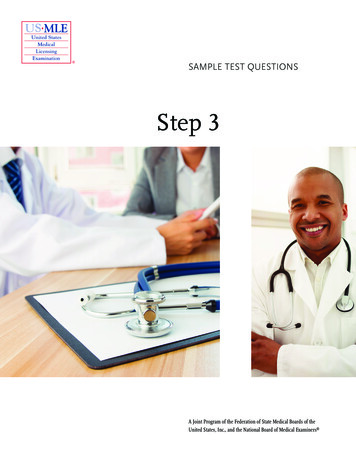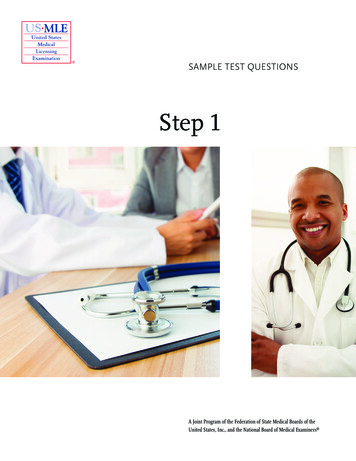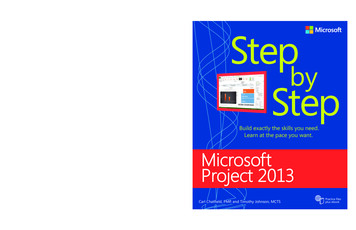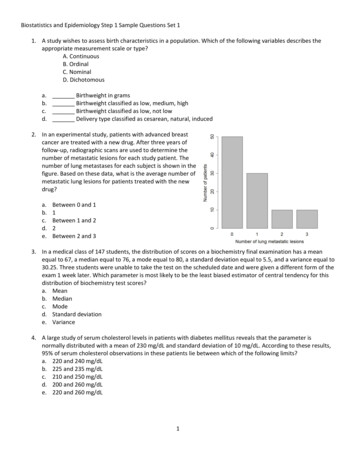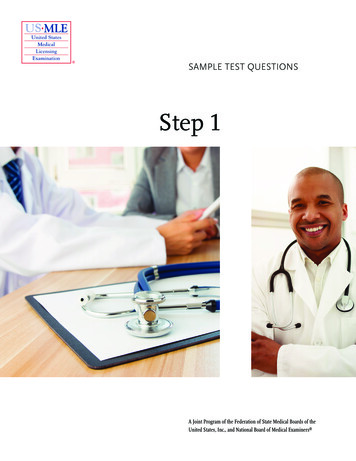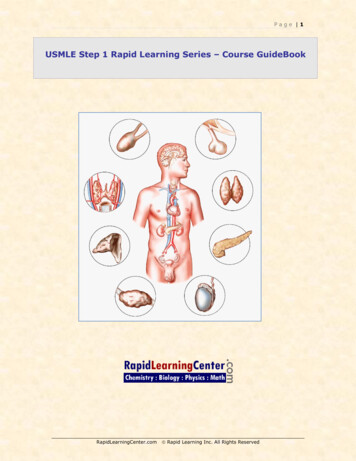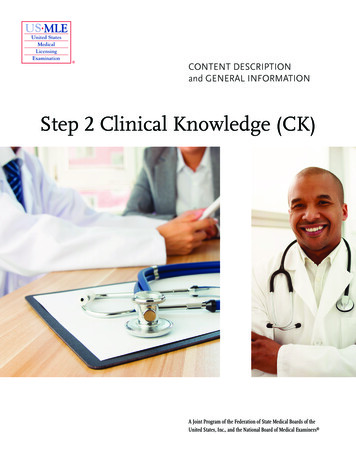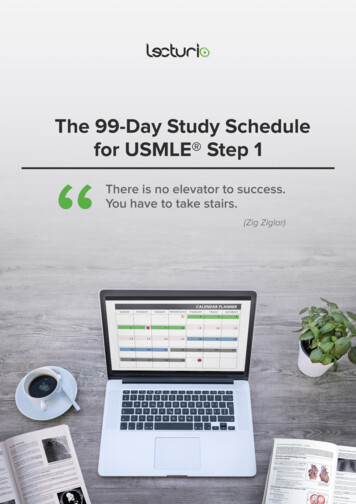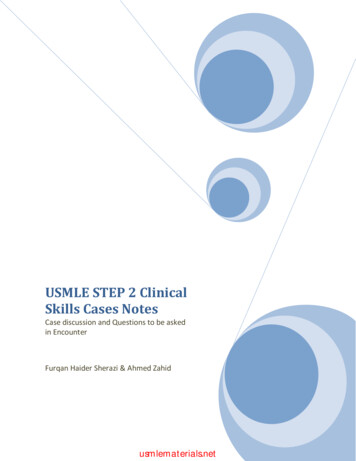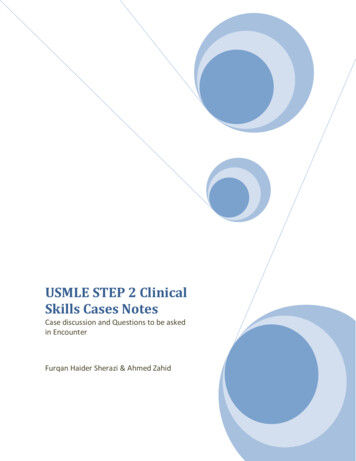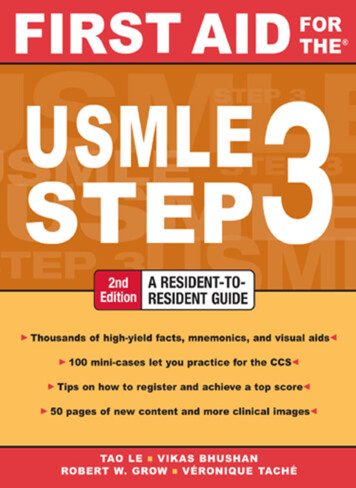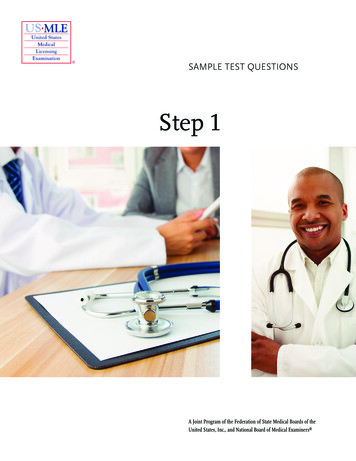
Transcription
SAMPLE TEST QUESTIONSStep 1A Joint Program of the Federation of State Medical Boards of theUnited States, Inc., and National Board of Medical Examiners
This booklet was updated February 2021.For Public ReleaseCopyright 2021 by the Federation of State Medical Boards of the United States, Inc. (FSMB), and National Board of MedicalExaminers (NBME ). All rights reserved. Printed in the United States of America. The United States Medical LicensingExamination (USMLE ) is a joint program of the FSMB and NBME.1
CONTENTSUSMLE Step 1 Test Question Formats 3Introduction to USMLE Step 1 Sample Test Questions . 4USMLE Laboratory Values . 5USMLE Step 1 Sample Test Questions . 8Answer Form for USMLE Step 1 Sample Test Questions . 48Answer Key for USMLE Step 1 Sample Test Questions . 492
USMLE STEP 1 TEST QUESTION FORMATSSingle-Item QuestionsA single patient-centered vignette is associated with one question followed by four or more response options.The response options are lettered (A, B, C, D, E). A portion of the questions require interpretation of graphicor pictorial materials. You are required to select the best answer to the question. Other options may bepartially correct, but there is only ONE BEST answer. This is the traditional, most frequently used multiplechoice question format on the examination.Strategies for Answering Single One-Best-Answer Test QuestionsThe following are strategies for answering one-best-answer items: Read each patient vignette and question carefully. It is important to understand what is being asked.Try to generate an answer and then look for it in the response option list.Alternatively, read each response option carefully, eliminating those that are clearly incorrect.Of the remaining options, select the one that is most correct.If unsure about an answer, it is better to guess since unanswered questions are automatically countedas wrong answers.Example ItemA 32-year-old woman with type 1 diabetes mellitus has had progressive renal failure during the past 2 years.She has not yet started dialysis. Examination shows no abnormalities. Her hemoglobin concentration is 9 g/dL,hematocrit is 28%, and mean corpuscular volume is 94 μm3. A blood smear shows normochromic, normocyticcells. Which of the following is the most likely cause?(A)(B)(C)(D)(E)Acute blood lossChronic lymphocytic leukemiaErythrocyte enzyme deficiencyErythropoietin pathic hemolysisPolycythemia veraSickle cell diseaseSideroblastic anemiaβ-Thalassemia trait(Answer: D)NOTE: Some item types that appear on the Step 1 examination are NOT depicted in the sample items providedin this booklet, eg, items with multimedia features, such as audio. Also, when additional item formats areadded to the exam, notice will be provided at the USMLE website: http://www.usmle.org. You must monitorthe website to stay informed about the types of items that occur in the exam, and you must practice with thedownloadable sample test items available on the USMLE website to be fully prepared for the examination.3
INTRODUCTION TO USMLE STEP 1 SAMPLE TEST QUESTIONSThe following pages include 119 sample test questions. Most of these questions are the same as those you caninstall on your computer from the USMLE website. Please note that reviewing the sample questions as theyappear on pages 8–47 is not a substitute for practicing with the test software. You should download and runthe Step 1 tutorial and practice test items that are provided on the USMLE website well before your test date.The sample materials available on the USMLE website include an additional item with associated audiofindings that does not appear in this booklet. You should become familiar with this item format that will beused in the actual examination.Although the sample questions exemplify content on the Step 1 examination overall, they may not reflect thecontent coverage on individual examinations. In the actual examination, questions will be presented inrandom order; they will not be grouped according to specific content. The questions will be presented one at atime in a format designed for easy on-screen reading, including use of the USMLE Laboratory Values table(included here on pages 5–7) and some pictorials. Photographs, charts, and x-rays in this booklet are not ofthe same quality as the pictorials used in the actual examination. In addition, you will be able to adjust thebrightness and contrast of pictorials on the computer screen.To take the following sample test questions as they would be timed in the actual examination, you shouldallow a maximum of 1 hour for each 40-item block, and a maximum of 58 minutes, 30 seconds, for the 39-itemblock, for a total of 2 hours, 58 minutes, 30 seconds. Please note that the third block has 39 items instead of40 because the multimedia item has been removed, and the recommended time to complete the block hasbeen adjusted accordingly. Please be aware that most examinees perceive the time pressure to be greaterduring an actual examination. All examinees are strongly encouraged to practice with the downloadableversion to become familiar with all item formats and exam timing. An answer form for recording answers isprovided on page 48. An answer key is provided on page 49. In the actual examination, answers will beselected on the screen; no answer form will be provided.4
USMLE Laboratory ValuesSERUMGeneral Chemistry:ElectrolytesSodium (Na )Potassium (K )Chloride (Cl–)Bicarbonate (HCO3–)Urea nitrogenCreatinineGlucoseCalciumMagnesium (Mg2 )Phosphorus (inorganic)Hepatic:Alanine aminotransferase (ALT)Aspartate aminotransferase (AST)Alkaline phosphataseAmylaseBilirubin, Total // DirectProteins, riglyceridesIron Studies:FerritinIronTotal iron-binding capacityTransferrinReference RangeSI Reference Intervals136–146 mEq/L3.5–5.0 mEq/L95–105 mEq/L22–28 mEq/L7–18 mg/dL0.6–1.2 mg/dLFasting: 70–100 mg/dLRandom, non-fasting: 140 mg/dL8.4–10.2 mg/dL1.5–2.0 mg/dL3.0–4.5 mg/dL136–146 mmol/L3.5–5.0 mmol/L95–105 mmol/L22–28 mmol/L2.5–6.4 mmol/L53–106 μmol/L3.8–5.6 mmol/L 7.77 mmol/L2.1–2.6 mmol/L0.75–1.0 mmol/L1.0–1.5 mmol/L10–40 U/L12–38 U/L25–100 U/L25–125 U/L0.1–1.0 mg/dL // 0.0–0.3 mg/dL6.0–7.8 g/dL3.5–5.5 g/dL2.3–3.5 g/dL10–40 U/L12–38 U/L25–100 U/L25–125 U/L2–17 μmol/L // 0–5 μmol/L60–78 g/L35–55 g/L23–35 g/LNormal: 200 mg/dLHigh: 240 mg/dL40–60 mg/dL 160 mg/dLNormal: 150 mg/dLBorderline: 151–199 mg/dL 5.2 mmol/L 6.2 mmol/L1.0–1.6 mmol/L 4.2 mmol/L 1.70 mmol/L1.71–2.25 mmol/LMale: 20–250 ng/mLFemale: 10–120 ng/mLMale: 65–175 µg/dLFemale: 50–170 μg/dL250–400 µg/dL200–360 mg/dL20–250 μg/L10–120 μg/L11.6–31.3 μmol/L9.0–30.4 μmol/L44.8–71.6 μmol/L2.0–3.6 g/L5Continued on Next Page
USMLE Laboratory Values (continued)Reference RangeSI Reference IntervalsMale: 4–25 mIU/mLFemale: premenopause 4–30 mIU/mLmidcycle peak 10–90 mIU/mLpostmenopause 40–250 mIU/mLMale: 6–23 mIU/mLFemale: follicular phase 5–30 mIU/mLmidcycle 75–150 mIU/mLpostmenopause 30–200 mIU/mLFasting: 5 ng/mLProvocative stimuli: 7 ng/mLMale: 17 ng/mLFemale: 25 ng/mL0800 h: 5–23 μg/dL1600 h: 3–15 μg/dL2000 h: 50% of 0800 h0.4–4.0 μU/mL100–200 ng/dL25%–35%5–12 μg/dL0.9–1.7 ng/dL8%–30% of administered dose/24 h10–60 pg/mLMale: 3.0–10.0 mg/24 hFemale: 2.0–8.0 mg/24 hMale: 8–20 mg/24 hFemale: 6–15 mg/24 h4–25 IU/L4–30 IU/L10–90 IU/L40–250 IU/L6–23 IU/L5–30 IU/L75–150 IU/L30–200 IU/L 5 μg/L 7 μg/L 17 μg/L 25 μg/L138–635 nmol/L82–413 nmol/LFraction of 0800 h: 0.500.4–4.0 mIU/L1.5–3.1 nmol/L0.25–0.3564–155 nmol/L12.0–21.9 pmol/L0.08–0.30/24 h10–60 ng/L8.2–27.6 μmol/24 h5.5–22.0 μmol/24 h28–70 μmol/24 h21–52 μmol/24 h76–390 mg/dL0–380 IU/mL650–1500 mg/dL50–300 mg/dL0.76–3.90 g/L0–380 kIU/L6.5–15.0 g/L0.5–3.0 g/LMale: 97–137 mL/minFemale: 88–128 mL/minMale: 25–90 U/LFemale: 10–70 U/L45–200 U/L275–295 mOsmol/kg H2O3.0–8.2 mg/dL97–137 mL/min88–128 mL/min25–90 U/L10–70 U/L45–200 U/L275–295 mOsmol/kg H2O0.18–0.48 mmol/LGASES, ARTERIAL BLOOD (ROOM AIR)PO 2PCO2pH75–105 mm Hg33–45 mm Hg7.35–7.4510.0–14.0 kPa4.4–5.9 kPa[H ] 36–44 nmol/LCEREBROSPINAL FLUIDCell countChlorideGamma globulinGlucosePressureProteins, total0–5/mm3118–132 mEq/L3%–12% total proteins40–70 mg/dL70–180 mm H2O 40 mg/dL0–5 106/L118–132 mmol/L0.03–0.122.2–3.9 mmol/L70–180 mm H2O 0.40 g/LEndocrine:Follicle-stimulating hormoneLuteinizing hormoneGrowth hormone - arginine stimulationProlactin (hPRL)CortisolTSHTriiodothyronine (T3) (RIA)Triiodothyronine (T3) resin uptakeThyroxine (T4)Free T4Thyroidal iodine (123I) uptakeIntact PTH17-Hydroxycorticosteroids17-Ketosteroids, totalImmunoglobulins:IgAIgEIgGIgMOther, serum:Creatinine clearanceCreatine kinaseLactate dehydrogenaseOsmolalityUric acid6Continued on Next Page
USMLE Laboratory Values (continued)Reference RangeSI Reference IntervalsMale: 41%–53%Female: 36%–46%Male: 13.5–17.5 g/dLFemale: 12.0–16.0 g/dL25–35 pg/cell31%–36% Hb/cell80–100 μm30.41–0.530.36–0.46135–175 g/L120–160 g/L0.39–0.54 fmol/cell4.8–5.6 mmol Hb/L80–100 fLMale: 25–43 mL/kgFemale: 28–45 mL/kgMale: 20–36 mL/kgFemale: 19–31 0.043 L/kg0.028–0.045 L/kg0.020–0.036 L/kg0.019–0.031 L/kg4.5–11.0 .01–0.030.00–0.0075150–400 109/L25–40 seconds11–15 seconds 250 ng/mL25–40 seconds11–15 seconds 1.4 nmol/L0.5%–1.5%Male: 4.3–5.9 million/mm3Female: 3.5–5.5 million/mm3Male: 0–15 mm/hFemale: 0–20 mm/h 500/mm3 0.04 ng/mL0.005–0.0154.3–5.9 1012/L3.5–5.5 1012/L0–15 mm/h0–20 mm/h 0.5 109/L 0.04 µg/L 6% 42 mmol/molURINECalciumOsmolalityOxalateProteins, total100–300 mg/24 h50–1200 mOsmol/kg H2O8–40 μg/mL 150 mg/24 h2.5–7.5 mmol/24 h50–1200 mOsmol/kg H2O90–445 μmol/L 0.15 g/24 hBODY MASS INDEX (BMI)Adult: 19–25 kg/m2HEMATOLOGICComplete Blood Count:HematocritHemoglobin, bloodMean corpuscular hemoglobin (MCH)Mean corpuscular hemoglobin conc. (MCHC)Mean corpuscular volume (MCV)VolumePlasmaRed cellLeukocyte count (WBC)Neutrophils, segmentedNeutrophils, let countCoagulation:Partial thromboplastin time (PTT) (activated)Prothrombin time (PT)D-DimerOther, Hematologic:Reticulocyte countErythrocyte countErythrocyte sedimentation rate (Westergren)CD4 T-lymphocyte countTroponin IEndocrine:Hemoglobin A1c7
USMLE STEP 1 SAMPLE TEST QUESTIONSBLOCK 1, ITEMS 1-401.A 67-year-old woman with congenital bicuspid aortic valve is admitted to the hospital because of a 2-day history offever and chills. Current medication is lisinopril. Temperature is 38.0 C (100.4 F), pulse is 90/min, respirations are20/min, and blood pressure is 110/70 mm Hg. Cardiac examination shows a grade 3/6 systolic murmur that is bestheard over the second right intercostal space. Blood culture grows viridans streptococci susceptible to penicillin. Inaddition to penicillin, an antibiotic synergistic to penicillin is administered that may help shorten the duration of thispatient's drug treatment. Which of the following is the most likely mechanism of action of this additional antibioticon bacteria?(A)(B)(C)(D)(E)2.A 12-year-old girl is brought to the physician because of a 2-month history of intermittent yellowing of the eyes andskin. Physical examination shows no abnormalities except for jaundice. Her serum total bilirubin concentration is3 mg/dL, with a direct component of 1 mg/dL. Serum studies show a haptoglobin concentration and AST and ALTactivities that are within the reference ranges. There is no evidence of injury or exposure to toxins. Which of thefollowing additional findings is most likely in this patient?(A)(B)(C)(D)(E)3.Binding to DNA-dependent RNA polymeraseBinding to the 30S ribosomal proteinCompetition with p-aminobenzoic acidInhibition of dihydrofolate reductaseInhibition of DNA gyraseDecreased activity of UDP glucuronosyltransferaseGallstonesIncreased hemolysisIncreased serum alkaline phosphatase activityIneffective erythropoiesisDuring an experiment, drug X is added to a muscle bath containing a strip of guinea pig intestinal smooth muscle.Agonists are added to the bath, and the resultant effects on muscle tension are shown in the cle Tension Before Drug X (g)6.011.34.1Muscle Tension After Drug X (g)6.118.54.2Which of the following types of drugs is most likely to produce effects most similar to those of drug X?(A)(B)(C)(D)(E)α1-Adrenergic antagonistβ-Adrenergic antagonistCholinesterase inhibitorMonoamine oxidase inhibitorMuscarinic antagonist8
4.A 30-year-old woman, gravida 2, para 0, aborta 1, at 28 weeks' gestation comes to the office for a prenatal visit. Shehas had one previous pregnancy resulting in a spontaneous abortion at 12 weeks' gestation. Today, her vital signs arewithin normal limits. Physical examination shows a uterus consistent in size with a 28-week gestation. Fetalultrasonography shows a male fetus with no abnormalities. Her blood group is O, Rh-negative. The father's bloodgroup is B, Rh-positive. The physician recommends administration of Rho(D) immune globulin to the patient. Thistreatment is most likely to prevent which of the following in this mother?(A)(B)(C)(D)(E)5.A 55-year-old man is brought to the emergency department because of shortness of breath and confusion for4 hours. He has hypertension and chronic kidney disease requiring hemodialysis. An ECG shows low voltage withelectrical alternans. Physical examination is most likely to show which of the following findings?Blood Pressure(mm )(F)6.Development of natural killer cellsDevelopment of polycythemiaFormation of antibodies to RhDGeneration of IgM antibodies from fixing complement in the fetusImmunosuppression caused by RhD on erythrocytes from the fetusJugular malnormalPulse lnormalincreasedincreasednormalA 52-year-old woman begins pharmacotherapy after being diagnosed with type 2 diabetes mellitus. Four weekslater, her hepatic glucose output is decreased, and target tissue glucose uptake and utilization are increased. Whichof the following drugs was most likely prescribed for this ateglinideRepaglinide9
7.An asymptomatic 44-year-old man is found to have HIV infection during routine screening prior to donating blood.A complete blood count done at the time of the screening shows:HemoglobinHematocritLeukocyte countPlatelet countProthrombin timePartial thromboplastin time10 g/dL30%4600/mm315,000/mm312 sec (INR 1.1)23 secWhich of the following physical findings is most likely in this patient?(A)(B)(C)(D)(E)8.A 23-year-old woman with bone marrow failure is treated with a large dose of rabbit antithymocyte globulin. Tendays later, she develops fever, lymphadenopathy, arthralgias, and erythema on her hands and feet. Which of thefollowing is the most likely cause of these symptoms?(A)(B)(C)(D)(E)9.Deep venous thrombosisHemarthrosisPetechiaeSubungual hemorrhageVisceral hematomaCytokine secretion by natural killer cellsEosinophil degranulationImmune complex deposition in tissuesPolyclonal T-lymphocyte activationWidespread apoptosis of B lymphocytesAfter being severely beaten and sustaining a gunshot wound to the abdomen, a 42-year-old woman undergoesresection of a perforated small bowel. During the operation, plastic reconstruction of facial fractures, and openreduction and internal fixation of the left femur are also done. Thirty-six hours postoperatively, she is awake but notcompletely alert. She is receiving intravenous morphine via a patient-controlled pump. She says that she needs themorphine to treat her pain, but she is worried that she is becoming addicted. She has no history of substance usedisorder. She drinks one to two glasses of wine weekly. Which of the following initial actions by the physician ismost appropriate?(A)(B)(C)(D)(E)Reassure the patient that her chance of becoming addicted to narcotics is minusculeMaintain the morphine, but periodically administer intravenous naloxoneSwitch the patient to oral acetaminophen as soon as she can take medication orallySwitch the patient to intramuscular lorazepamSwitch the patient to intravenous phenobarbital10
10.A 22-year-old woman comes to the office because of a 4-day history of an itchy, red rash on her right arm. She hasno history of major medical illness and takes no medications. She says she has recently used a new hair dye. She is165 cm (5 ft 5 in) tall and weighs 61 kg (135 lb); BMI is 23 kg/m2. Her temperature is 37.0 C (98.6 F), pulse is70/min. respirations are 22/min, and blood pressure is 115/70 mm Hg. Examination of the right forearm shows thefindings in the photograph. Which of the following ligand receptor pairs most likely played a primary role in theproliferation of the T lymphocytes present at the site of the rash in this patient?(A)(B)(C)(D)(E)11.Six healthy subjects participate in a study of muscle metabolism during which hyperglycemia and hyperinsulinemiais induced. Muscle biopsy specimens obtained from the subjects during the resting state show significantly increasedconcentrations of malonyl-CoA. The increased malonyl-CoA concentration most likely directly inhibits which of thefollowing processes in these subjects?(A)(B)(C)(D)(E)(F)12.CD2 on T lymphocytes intercellular adhesion molecule (ICAM)-3 on epidermal Langerhans cellsCD28 on T lymphocytes CD80 on epidermal Langerhans cellsCD40L on T lymphocytes CD40 on epidermal Langerhans cellsCD45 on T lymphocytes CD28 on epidermal Langerhans cellsLymphocyte function-associated antigen-1 on T lymphocytes ICAM1 on epidermal Langerhans cellsFatty acid oxidationFatty acid idative phosphorylationOver 1 year, a study is conducted to assess the antileukemic activity of a new tyrosine kinase inhibitor in patientswith chronic myeloid leukemia in blast crisis. All patients enrolled in the study are informed that they would betreated with the tyrosine kinase inhibitor. They are assigned to successive dose cohorts of 300 to 1000 mg/day of thedrug. Six to eight patients are assigned to each dose. Treatment efficacy is determined based on the results ofcomplete blood counts and bone marrow assessments conducted regularly throughout the study. This study is bestdescribed as which of the following?(A)(B)(C)(D)(E)Case-control studyCrossover studyOpen-labeled clinical trialRandomized clinical trialSingle-blind, randomized, controlled trial11
13.A 63-year-old man is brought to the emergency department because of a 4-day history of increasingly severe left legpain and swelling of his left calf. He also has a 1-month history of increasingly severe upper midthoracic back pain.During this time, he has had a 9-kg (20-lb) weight loss despite no change in appetite. He has no history of majormedical illness. His only medication is ibuprofen. He is 180 cm (5 ft 11 in) tall and weighs 82 kg (180 lb); BMI is25 kg/m2. His vital signs are within normal limits. On examination, lower extremity pulses are palpable bilaterally.The remainder of the physical examination shows no abnormalities. An x-ray of the thoracic spine shows noabnormalities. A CT scan of the abdomen shows a 3-cm mass in the body of the pancreas; there are liver metastasesand encasement of the superior mesenteric artery. Ultrasonography of the left lower extremity shows afemoropopliteal venous clot. Which of the following is the most likely cause of this patient’s symptoms?(A)(B)(C)(D)(E)14.A 40-year-old woman comes to the physician because of a 6-month history of increased facial hair growth. Her lastmenstrual period was 4 months ago. She is 165 cm (5 ft 5 in) tall and weighs 70 kg (154 lb); BMI is 26 kg/m2. Herpulse is 80/min, and blood pressure is 130/82 mm Hg. Physical examination shows temporal balding and coarse darkhair on the upper lip and chin. Pelvic examination shows clitoral enlargement. Her serum testosterone concentrationis increased. Serum concentrations of androstenedione, dehydroepiandrosterone, and urinary 17-ketosteroids arewithin the reference ranges. Ultrasonography of the pelvis shows a 12-cm ovarian mass. Which of the following bestdescribes this mass?(A)(B)(C)(D)(E)15.Granulosa tumorOvarian carcinoidSertoli-Leydig tumorTeratomaThecomaA 35-year-old man comes to the physician because of pain and swelling of his right arm where he scraped it on atree branch 2 days ago. His temperature is 38.3 C (101 F). Examination of the right forearm shows edema around afluctuant erythematous lesion at the site of trauma. The area is extremely tender to palpation. Which of the followingis most likely the primary mechanism of the development of edema in this patient?(A)(B)(C)(D)(E)16.Carcinoid syndromeHypercoagulability from advanced malignancyMultiple endocrine neoplasiaSplenic artery aneurysm and embolic disease of the left lower extremitySuperior mesenteric artery syndromeDegranulation of eosinophilsDisruption of vascular basement membranesIncreased hydrostatic pressureRelease of thromboxaneSeparation of endothelial junctionsA 12-year-old boy is brought to the physician because of a 2-month history of headaches and a 6-day history ofnausea and vomiting. Funduscopic examination shows bilateral papilledema. He walks with a broad-based gait. AnMRI of the brain shows a tumor in the pineal region compressing the brain stem and leading to hydrocephalus. Thispatient most likely has impairment of which of the following oculomotor functions?(A)(B)(C)(D)(E)AbductionHorizontal pursuitOptokinetic nystagmusUpward gazeVestibulo-ocular reflex12
17.A 52-year-old man comes to the emergency department because of a 1-day history of nausea, vomiting, and rightsided abdominal pain that radiates to his back. He has not had fever or increased urinary frequency. He has a historyof type 2 diabetes mellitus, hyperlipidemia, hypertension, and atrial fibrillation. Current medications areatorvastatin, glyburide, hydrochlorothiazide, lisinopril, and warfarin. He smoked 1½ packs of cigarettes daily for 35years until he quit 6 months ago. He has had no recent alcoholic beverage or illicit drug use. He is 188 cm (6 ft 2 in)tall and weighs 109 kg (240 lb); BMI is 31 kg/m2. Temperature is 36.4 C (97.6 F), pulse is 88/min, respirations are20/min, and blood pressure is 165/92 mm Hg. Pulse oximetry on room air shows an oxygen saturation of96%. Physical examination discloses right upper quadrant and flank tenderness but no rebound tenderness orguarding. CT scan of the abdomen with and without contrast shows an enlarged right kidney and wedge-shapedareas of hypodensity; there is no evidence of nephrolithiasis. Which of the following is the strongest predisposingrisk factor for this patient's condition?(A)(B)(C)(D)(E)18.Atrial fibrillationHyperlipidemiaHypertensionPast smoking historyType 2 diabetes mellitusA 24-year-old man comes to the office because of a 2-day history of a red, itchy rash on his buttocks and legs. Fourdays ago, he returned from a cruise to the Caribbean, during which he swam in the ship’s pool and used the hot tub.He appears well. His vital signs are within normal limits. Physical examination shows the findings in thephotograph. The infectious agent causing these findings most likely began to proliferate in which of the followinglocations?(A)(B)(C)(D)(E)Apocrine glandDermisEccrine glandHair follicleSebaceous gland13
19.An otherwise healthy 45-year-old man comes to the physician because of a 3-week history of progressive epigastricheartburn and a 4.5-kg (10-lb) weight loss. The pain tends to be more severe at night and occurs 1 to 3 hours aftermeals during the day. He has had similar episodes with lesser intensity during the past year. Abdominal examinationshows tenderness to deep palpation. Test of the stool for occult blood is positive. Endoscopy shows a bleeding 3-cmulcer in the antrum of the stomach. A photomicrograph of Steiner silver-stained tissue (400x) from a biopsy of thegastric mucosa adjacent to the ulcer is shown. Which of the following processes is most likely to be involved?(A)(B)(C)(D)20.A 14-year-old boy is brought to the emergency department after being hit with a baseball bat on the lateral side ofhis leg immediately below the knee. He is unable to dorsiflex his foot. Which of the following nerves is most likelyinjured?(A)(B)(C)(D)(E)21.Elaboration of proteases and urease with local tissue destructionHyperacidity and gastric ulcer developmentIngestion of preformed toxins in contaminated well waterSpirochete invasion of gastric cellsCommon fibular (peroneal)FemoralObturatorSuralTibialA 26-year-old woman is brought to the emergency department because of an 8-hour history of severe back andabdominal pain and mild but persistent vaginal bleeding. Ultrasonography of the abdomen shows a 2-cm ectopicpregnancy in the ampulla. The ampulla has ruptured into the surrounding tissue. Fluid from this rupture will mostlikely be found in which of the following locations?(A)(B)(C)(D)(E)Lesser peritoneal cavityMesometriumPouch of DouglasUterine cavityVagina14
22.A 46-year-old woman with active ankylosing spondylitis comes to the office for a follow-up examination. The useof various conventional nonsteroidal anti-inflammatory drugs has been ineffective. Sulfasalazine treatment also hasnot resulted in improvement. The most appropriate next step in treatment is administration of a drug that inhibitswhich of the following?(A)(B)(C)(D)(E)(F)23.A 55-year-old man comes to the physician because of a 2-week history of recurrent, widespread blister formation.Physical examination shows lesions that are most numerous in the flexural areas including the axillae and groin. Theblisters do not break easily, and there are no oral lesions. These blisters are most likely the result of adhesion failureinvolving which of the following?(A)(B)(C)(D)(E)24.Basement membraneDermal papillaeLangerhans cellsMelanocytesMerkel cellsA 17-year-old girl is brought to the emergency department 30 minutes after her boyfriend found her unconscious nextto an empty bottle of acetaminophen. It is suspected that she ingested the tablets approximately 12 hours ago. Herserum acetaminophen concentration is markedly increased. Treatment with activated charcoal and acetylcysteine isinitiated. Approximately 48 hours later, the patient develops jaundice, and her serum AST activity is 3000 U/L.Which of the following best explains the jaundice in this toxic T-lymphocyte antigen 4Epidermal growth factorInterleukin-1 (IL-1)Tumor necrosis factor αActivation of biliverdin reductaseDecreased bilirubin conjugationDecreased generation of urobilinogenIncreased hemolysisIncreased serum glutathione concentrationA 72-year-old woman comes to the physician because of a 3-day history of fever, shortness of breath, difficultyswallowing, chest pain, and cough. She is frail. Physical examination shows tachypnea and equal pulses bilaterally.Percussion of the chest shows dullness over the right lower lung field. Laboratory studies show arterial hypoxemiaand decreased PCO2. A chest x-ray shows an area of opacification in the lower region of the right lung. Which of thefollowing is the most likely cause of this patient's condition?(A)(B)(C)(D)(E)Alveolar proteinosisAspirationCigarette smokingEmphysemaVasculitis15
26.A 62-year-old man is admitted to the hospital for evaluation of abdominal pain. During the interview, he responds tothe questions with a single word and sometimes with sarcastic answers. He does not engage in eye contact, and hefrowns as he tells the physician that this is the third time he has been asked these questions. Which of the followingis the most appropriate response by the physician?(A)(B)(C)(D)(E)27.A 54-year-old man comes to the physician because of episodes of fainting for 3 months. He also has had difficultyperforming daily tasks because he is easily fatigued. He had a myocardial infarction 12 years ago. His pulse is40/min, respirations are 18/min, and blood pressure is 138/85 mm Hg. Physical examination shows evidence ofcannon a waves. An ECG shows a P-wave rate of 90/min, and an R-wave rate of 40/min, with no apparent relationbetween the two. Which of the following is the most likely diagnosis?(A)(B)(C)(D)(E)28."Can you tell me more about your abdominal pain?""I understand that you do not feel well, but I need to get a history here.""I'll come back once you've calmed down, and we can talk more then.""Listen, if you choose not to cooperate, I'm not going to be able to help you.""You sound upset. Tell me a little more about that."First-degree atrioventricular blockRight bundle branch blockSecond-degree atrioventricular block, type ISecond-degree atrioventricular block, type IIThird-degree atrioventricular blockA 42-year-old woman comes to the physician for a routine examination. She says that she has felt well except foroccasional episodes of constipation, abdominal discomfort, and mild fatigue. She was treated for a renal calculus 10years ago and was told she had a "lazy gallbladder." Her pulse is 82/min, and blood pressure is 150/80 mm Hg.Physical examination shows no other abnormalities. Laboratory studies show:3 million/mm3Erythrocyte countSerumK Cl–Ca2 PhosphorusAlkaline phosphatase4.5 mEq/L107 mEq/L12 mg/dL2.2 mg/dL95 U/LThe most likely cause of this patient's condition is a small, well-defined nodule in which of the following locations?(A)(B)(C)(D)(E)(F)Adrenal glandAnterior pituitary glandGallbladderKidneyParathyroid glandThymus16
29.A 72-year-old woman is brought to the emergency department by her husband because of a 1-hour history ofdifficulty walking and speaking. The husband
the Step 1 tutorial and practice test items that are provided on the USMLE website well before your test date. The sample materials available on the USMLE
